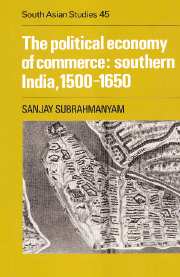Book contents
- Frontmatter
- Contents
- List of illustrations
- List of tables
- Preface
- Abbreviations used
- Introduction
- 1 The political economy of southern India, 1500–1650: preliminary remarks
- 2 Coastal trade and overland trade: complementarities and contradictions
- 3 Overseas trade, 1500–1570: traders, ports and networks
- 4 Overseas trade, 1570–1650: expansion and realignment
- 5 Europeans and Asians in an age of contained conflict
- 6 External commerce and political participation
- 7 Situating trade: models and methodological strategies
- Conclusion
- A note on currency and weights
- Glossary
- Note on sources
- Bibliography
- Index
- CAMBRIDGE SOUTH ASIAN STUDIES
7 - Situating trade: models and methodological strategies
Published online by Cambridge University Press: 13 January 2010
- Frontmatter
- Contents
- List of illustrations
- List of tables
- Preface
- Abbreviations used
- Introduction
- 1 The political economy of southern India, 1500–1650: preliminary remarks
- 2 Coastal trade and overland trade: complementarities and contradictions
- 3 Overseas trade, 1500–1570: traders, ports and networks
- 4 Overseas trade, 1570–1650: expansion and realignment
- 5 Europeans and Asians in an age of contained conflict
- 6 External commerce and political participation
- 7 Situating trade: models and methodological strategies
- Conclusion
- A note on currency and weights
- Glossary
- Note on sources
- Bibliography
- Index
- CAMBRIDGE SOUTH ASIAN STUDIES
Summary
Introduction
In this final chapter, the purpose is to attempt a general characterisation of the place of trade (in particular external trade) in the political economy of sixteenth and seventeenth century southern India. In the early chapters of this study, we traced the broad outline of state structures and fiscal regimes, the evolving structure of overland and coastal trade, and its relations with overseas trade. Subsequent sections dealt in detail with long-distance overseas commerce, and with certain specific issues which arose in that context. It is in the light of the information and arguments contained in these earlier chapters that the present one will be framed.
It is unfortunate but true that abstract thought on the relationship between trade, whether external or internal, and the material conditions in which they found themselves did not greatly exercise the inhabitants of southern India in the period. A few desultory remarks may be found, in treatises on royal conduct, on this theme, but these are usually normative, and do not rise above a regrettable level of vagueness. The poem Amuktamalyada, usually attributed to the Vijayanagara ruler Krishna Deva Raya [r. 1509–29] addresses the issue in two verses. The one notes:
A king should govern his ports so as to increase their trade by encouraging the import of horses, elephants, gems, sandal, pearls etc.; he should offer protection suited to the conditions of their race to people who migrate from other countries, owing to famine, pestilence and calamities.
(Verse XLII)- Type
- Chapter
- Information
- The Political Economy of Commerce: Southern India 1500–1650 , pp. 343 - 365Publisher: Cambridge University PressPrint publication year: 1990



